
If you are working on a building project with a large space, you might want to use it for a broad range of activities.
Depending on the building is, the activities could be:
- amplified music performances
- quiet acoustic music performances
- loud acoustic music performances
- drama performances
- conferences or lectures
- sports events
- exams
- fairs
- and more.
The space will not only need to be very flexible physically to accommodate these activities, but also acoustically. In fact, each activity requires very different sound reverberation conditions to work optimally and ensure acoustic comfort for the users (and listeners for some cases).
Note: If you need a refresher on the basics of sound reverberation, go to this page.
One of the ways to make a space acoustically flexible is by changing the sound absorption in the space. Essentially, you either:
- reveal or add sound absorptive materials to make the room less reverberant, and;
- hide or take away sound absorptive materials to make the room more reverberant (or more lively).
This is done with systems called variable acoustic systems or also variable sound absorption systems.
Note: Other ways of changing the sound reverberation in spaces is by changing their volume or artificially adding reverberation with electroacoustic systems.
What are these systems? This post presents, with pros and cons explained, some of the most commonly used variable sound absorption systems, including:
- Acoustic curtains / drapes
- Acoustic banners / blinds
- Rotating acoustic systems
- Hinged acoustic panels
- Acoustic sliding panels
- Moveable acoustic panels
- Other variable acoustic systems
Enjoy the read!
(See at the end the references used to confirm the concepts)

Do you want to be notified when new posts are published?
Why don’t you subscribe to Atelier Crescendo’s newsletter by clicking here?
Acoustic Curtains/Drapes
Acoustic curtains can be either:
- extended along walls to lower the sound reverberation in a space, or;
- stored in corners or in dedicated cupboards to increase the sound reverberation.

 Pros
Pros

Relatively cheap
Acoustic curtain systems mostly involve fabric and a rail, which is relatively inexpensive compared to other sound absorption materials or systems.

Easy to operate
They are also manually operated. No need for a complicated motorised system.

Quick to deploy
Unlike certain systems that take a few minutes to deploy (or even longer), deploying acoustic curtains only takes a few seconds.
 Cons
Cons
 Limited sound absorption
Limited sound absorption
Curtains are not the most efficient sound absorber. Consequently, you need more material to cover large wall surfaces and provide a sufficient variation in the reverberation time. If you design a space with a large volume, you could also struggle to find enough available space.
 Absorb sound at mid and high frequencies
Absorb sound at mid and high frequencies
As a fibrous material, fabric is more efficient at absorbing sound at mid and high frequencies than at low frequencies.
Therefore, you will need to find other sound absorption means if you want to control the sound reverberation at low frequencies (especially in spaces where music is played).
Vertical Acoustic Banners/Blinds
Fixed/hung from the ceilings or high up on the walls, acoustic banners can be:
- rolled down walls (most of the time) to lower the sound reverberation in a space, or;
- rolled up in dedicated housing to increase the sound reverberation.
Acoustic banner systems can either be manually operated or (automatically) motorised.

 Pros
Pros
 Relatively cheap (for manual systems)
Relatively cheap (for manual systems)
Banners that are not motorised can be relatively inexpensive compared to other sound absorption materials or systems.
 Easy to operate
Easy to operate
Manually operated systems are very easy to deploy. Although some manufacturers have designed motorised systems that are very straightforward to use.
They can automatically deploy the banners with different modes, including which banners to action and how much to extend them by.
 Quick to deploy
Quick to deploy
Unlike certain systems that take a long time to deploy, acoustic banner systems just take a few minutes, especially when they are motorised.
 Cons
Cons
 More expensive(for motorised systems)
More expensive(for motorised systems)
If you have a motorised banner system, be mindful that you will need to plan for a larger budget.
 Absorb sound at mid and high frequencies
Absorb sound at mid and high frequencies
Similar to acoustic curtains, banners are made of porous or fibrous materials, so they are more efficient at absorbing sound at mid and high frequencies than at low frequencies.
Although, some recent research found ways to increase the low frequency absorption by creating dedicated alcoves (visit this page for more information).
Rotating Acoustic Systems
Rotating acoustic systems work by having surfaces of different acoustic properties that, by rotating them around a given axis, you can expose or hide whether you want to absorb, reflect and/or even diffuse sound that hits the elements.
Acoustic rotating systems can be manually operated or (automatically) motorised. Used for very specific and unique applications (such as music performance facilities), they are usually a custom made piece of joinery.
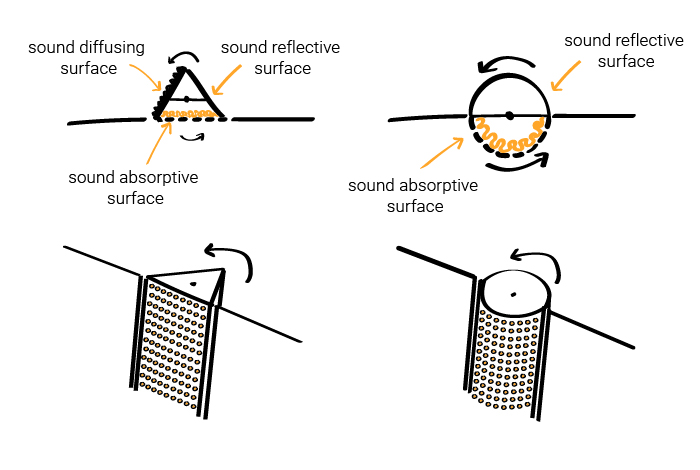
 Pros
Pros
 Easy to operate
Easy to operate
Sometimes, they can just be manually operated. No need for complicated motorised systems.
 Quick to deploy
Quick to deploy
Unlike certain systems that take a long time to deploy, rotating the elements to expose the right surface just takes a few minutes.
 Flexible absorption
Flexible absorption
Different degrees of acoustic treatment can be brought to a space. It is not all absorptive, reflective or diffusive.
This also leaves the users of the space free to adjust its acoustic characteristics to their own taste.
 Cons
Cons
 More expensive
More expensive
Firstly, acoustic rotating elements are expensive because they are generally custom made.
Cost can increase even more if you choose to have them motorised and automated.
 Too many options
Too many options
Flexibility can also be a disadvantage because the number of configurations can create confusion on which one is best for a given activity or performance.
 Sound absorption at mid and high frequencies
Sound absorption at mid and high frequencies
The sound absorptive side of rotating systems is usually made with porous or fibrous materials with relatively small cavities.
This makes rotating panels more efficient at absorbing sound at mid and high frequencies than at low frequencies.
Therefore, you will need to find other sound absorption means if you want to control the sound reverberation at low frequencies (especially in spaces where music is played).
Hinged Acoustic Panels
Acoustic hinged panels are generally located on the walls.
Their principle is very simple: you open or close them to expose or hide surfaces with different acoustic properties, sound reflective, absorptive or diffusive.
Most of the time hinged acoustic panels are manually operated.

 Pros
Pros
 Easy to make
Easy to make
Most hinged panels are relatively easy pieces of joinery to design and make.
 Relatively cheap
Relatively cheap
Depending on the acoustic treatment you use, hinged panels can also be fairly cheap to make.
 Easy to operate
Easy to operate
With only two options (open or closed), it can’t be more simple to operate hinged panels.
 Quick to deploy
Quick to deploy
It only takes seconds to open or close hinged panels.
Although, if the space is large and you have a fair number of panels to operate, it might take you a few minutes.
 Efficient sound absorber
Efficient sound absorber
Depending on the size of the panels and the thickness of the sound absorber, hinged acoustic panel systems can be very efficient at absorbing sound.
Therefore, the variation between the most ‘dead’ and the most ‘reverberant’ conditions can be:
– larger;
– achieved with less material.
 Cons
Cons
 Absorb sound at mid and high frequencies
Absorb sound at mid and high frequencies
Hinged acoustic panels are usually made with porous or fibrous materials, making them more efficient at absorbing sound at mid and high frequencies than at low frequencies.
Therefore, you will need to find other sound absorption means if you want to control the sound reverberation at low frequencies (especially in spaces where music is played).
 May not be visually appealing
May not be visually appealing
Although tastes for interior design can be very personal, it could be difficult merge hinged acoustic panels with the interior design of a space.
Acoustic Sliding Panels
Most of the time, acoustic sliding panels are installed on the walls.
They are made with two rigid panels that are slotted or slatted. By manually or automatically sliding them against each other, you reveal or hide an acoustic absorber in the cavity behind.
So that:
- opening the slots reveals the absorber and lowers the sound reverberation in the space, and;
- closing the slots hides the absorber and increases the sound reverberation.
Depending on the complexity of your project, it is likely that you will need a joiner to make the sliding panels tailored for your application.
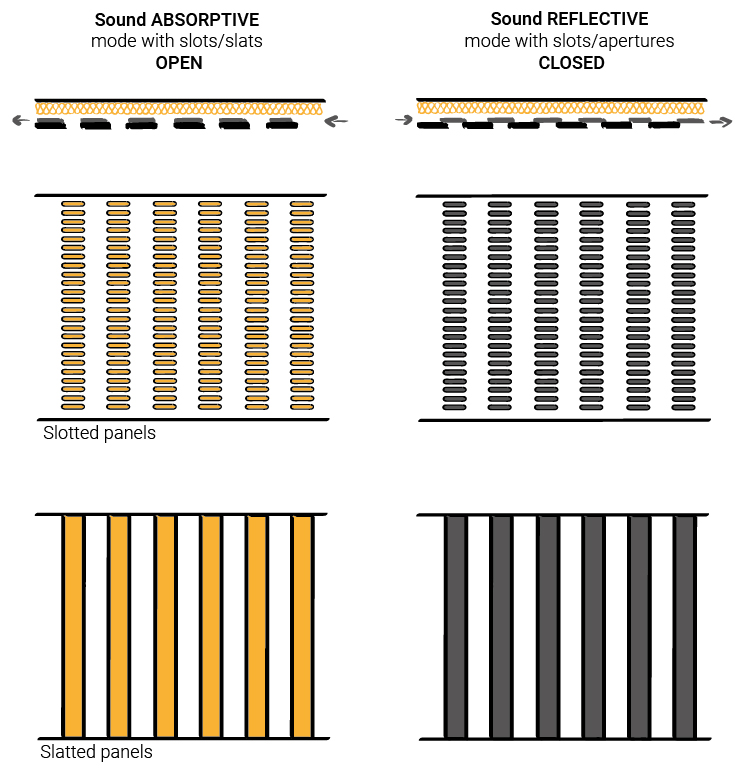
 Pros
Pros
 Easy to operate
Easy to operate
With just two options (slots open or closed), it can’t be more simple to operate acoustic sliding panels.
 Quick to deploy
Quick to deploy
It just takes a few seconds to slide the panels and open or close the slots (whether the systems are manually operated or motorised).
 Visually appealing
Visually appealing
Although tastes for interior design can be very personal, sliding panels are generally more visually appealing compared to other variable absorption systems.
Sometimes, they are even an integral part of the interior design of a space.
 Efficient sound absorber
Efficient sound absorber
Depending on the size of the slats/slots and the sound absorber in the cavity, acoustic sliding panel systems can be fairly efficient at absorbing sound.
Therefore, the variation between the most ‘dead’ and the most ‘reverberant’ conditions can be:
– larger;
– achieved with less material.
 Cons
Cons
 Can be expensive
Can be expensive
Compared to other ‘simpler’ variable sound absorption systems, you need to plan for a larger budget.
 Sound absorption at mid and high frequencies
Sound absorption at mid and high frequencies
The sound absorptive side of sliding panels is usually made with a porous or fibrous material with relatively small cavities. This makes them more efficient at absorbing sound at mid and high frequencies than at low frequencies.
Therefore, you will need to find other sound absorption means if you want to control the sound reverberation at low frequencies (especially in spaces where music is played).
Moveable/Portable Acoustic Panels
Also called portable acoustic panels/partitions or free-standing acoustic panels, acoustic moveable panels are elements made with a porous or fibrous material and stood on the floor where you want to absorb sound.
They can come in different shapes and arrangements:
- single flat panel,
- single curved panel,
- multiple flat panels hinged together,
- etc.
Moveable acoustic panels are often used in recording studios to absorb the first reflections to the microphone.
They are also be used to control the sound reverberation within spaces with an amount proportional to the volume (… of the space!).
To find examples of moveable acoustic panels, visit the Acoustic Design Catalogue here.
Reminder: If you need a refresher on the basics of sound reverberation, go to this page.

 Pros
Pros
 Easy to make
Easy to make
Moveable panels can be found as an off-the-shelf solution, but they are also easy pieces of joinery to design and make.
 Relatively cheap
Relatively cheap
Moveable panels are fairly cheap compared to other solutions offering variable sound absorption.
 Quick & easy to operate
Quick & easy to operate
Carrying and deploying moveable panels is a quick and easy task manageable by a single person.
Although an extra pair of hands may be required if a large number of panels has to be moved around a large space. This will obviously take longer too.
 Very efficient sound absorber
Very efficient sound absorber
Moveable panels are very efficient sound absorbers for the following reasons:
– they can be made with Class A absorbers (highest sound absorption class).
– they are positioned away from hard surfaces like the walls (an absorber against a hard surface is not as efficient as when it is away from it).
– they are generally located at the same height as that of the source and/or listening positions.
Therefore, the variation between the most ‘dead’ and the most ‘reverberant’ conditions can be:
– larger;
– achieved with less material.
 Flexible location
Flexible location
Unlike most variable sound absorption systems, the location of the moveable panels is very flexible depending on the event or the use we want to make out of it.
 Cons
Cons
 Absorb sound at mid and high frequencies
Absorb sound at mid and high frequencies
Acoustic moveable panels are usually made with porous or fibrous materials, making them more efficient at absorbing sound at mid and high frequencies than at low frequencies.
Therefore, you will need to find other sound absorption means if you want to control the sound reverberation at low frequencies (especially in spaces where music is played).
 May not be visually appealing
May not be visually appealing
Although tastes for interior design can be very personal, it could be difficult to merge acoustic moveable panels with the interior design of a space.
![]() Might not be practical for large volumes
Might not be practical for large volumes
The bigger the volume, the more panels are needed to control the sound reverberation within the space.
Therefore, from a certain room size, it could take a certain time and require a few people to deploy the panels. So moveable panels might not be the most practical solution for large spaces.
![]() Limited height for installation
Limited height for installation
Moveable panels are only be located on the floor.
This can potentially cancel some early sound reflections, reaching the listening/receiving position, so much needed for non-amplified musical or spoken performances (seethis page about the importance of early reflections).
 Requires storage
Requires storage
When not in use, it is important to consider storage space.
This way, they don’t absorb sound and the reverberation conditions can be higher in the space if needed.
Other Variable Sound Absorption Systems
When thinking about variable sound absorption design, the above solutions are the most commonly used. Although, many others could be specifically designed and made for a particular project.
However, it is still worth mentioning two more systems:
- Inflatable membranes that (are patented and) have a unique way of absorbing sound at low frequencies, and;
- Retractable seating whose first intent is not to vary the sound reverberation of a space but still does it well.
Inflatable membranes
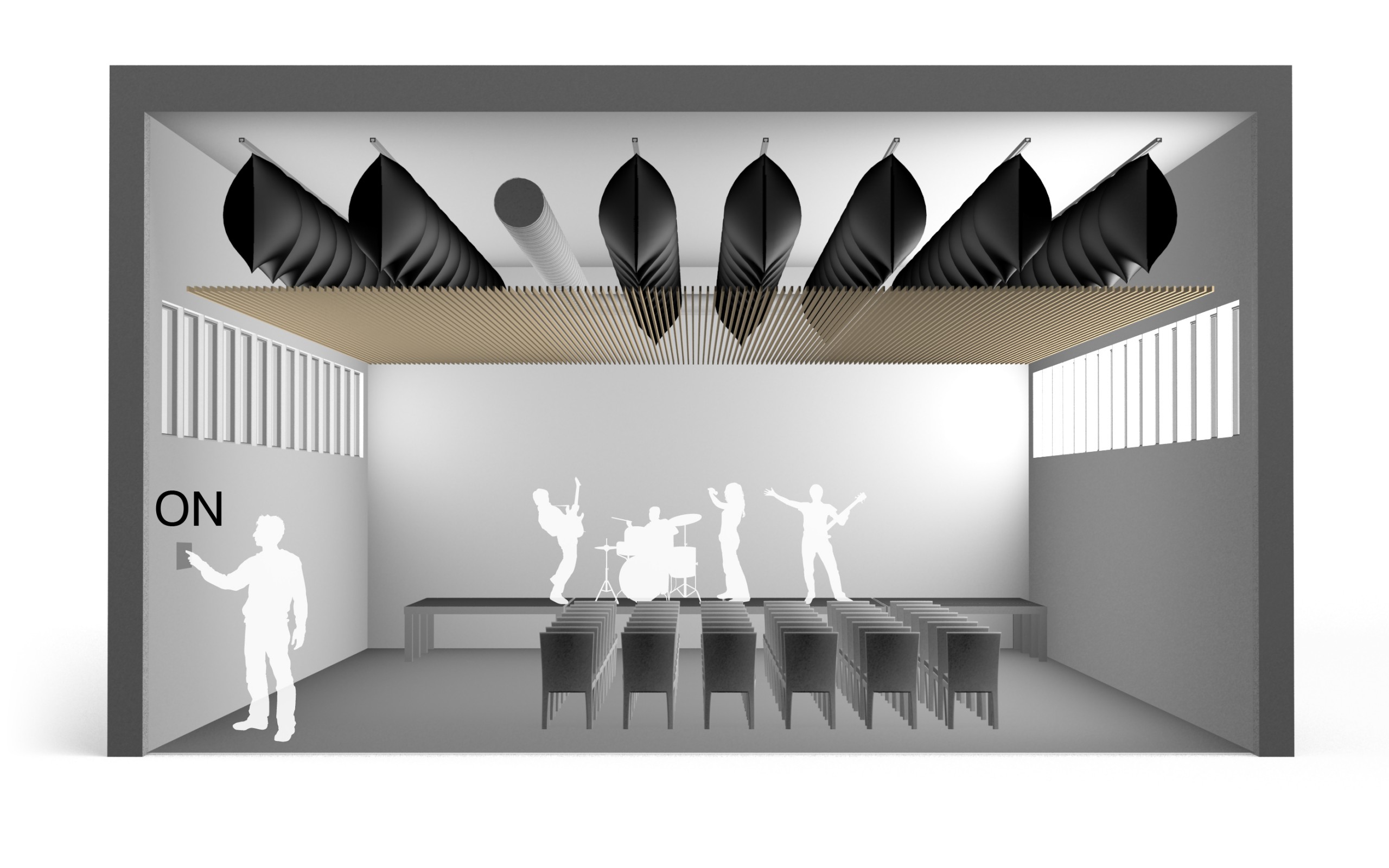
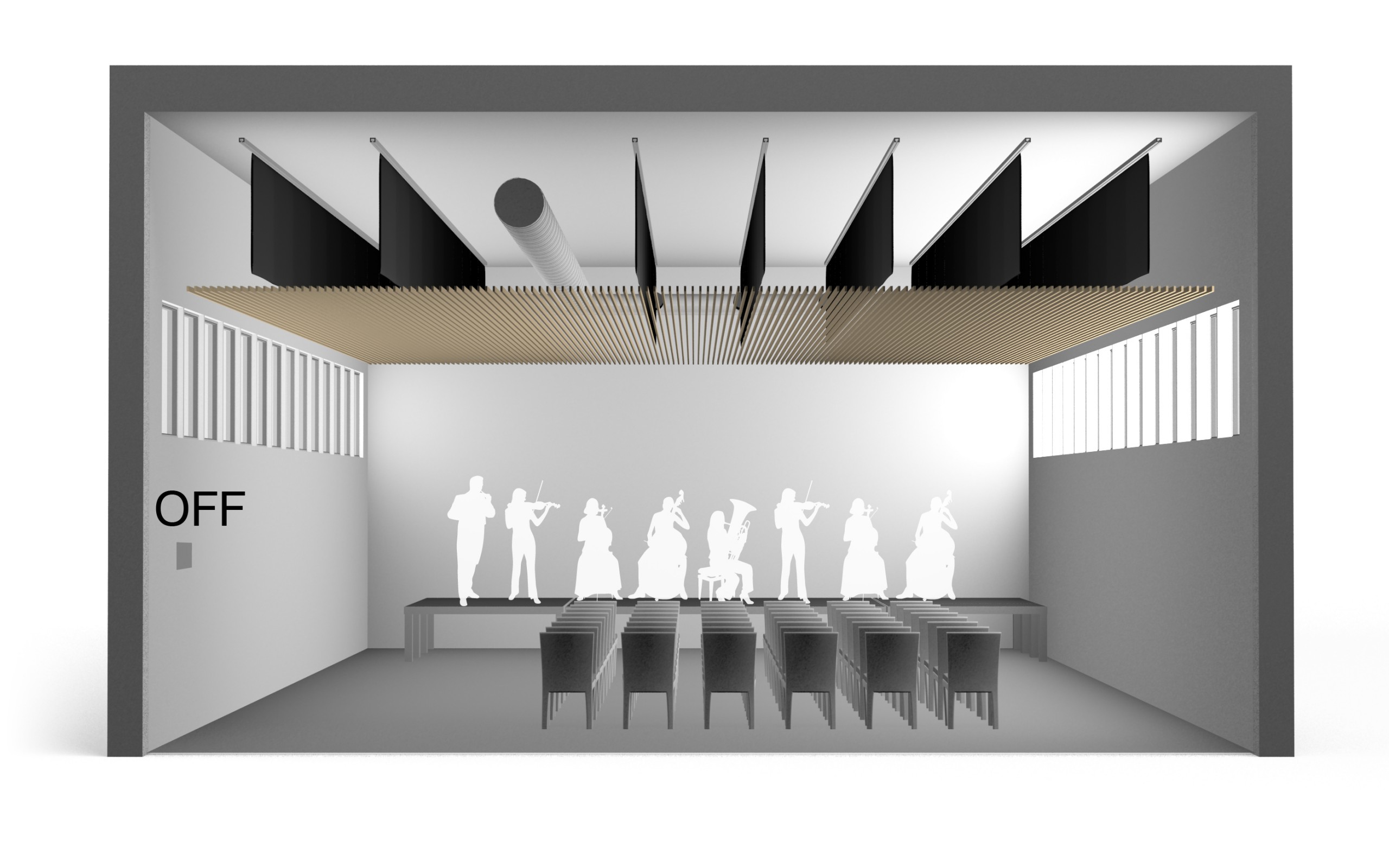
Patented by Flexacoustics, aQflex and aQtube include membranes that, when inflated, will absorb sound at low frequencies.
They are a good option to change the sound reverberation conditions of spaces from acoustic music performances (deflated) to amplified music performances (inflated).
An interesting use is for retrofit projects. A very common practice to increase the low frequency absorption within existing performance spaces is to include new (and heavy!) suspended ceiling systems.
All structures might not be able to support the extra weight. So a lighter inflatable membrane system could be a good alternative.
Retractable upholstered seating systems
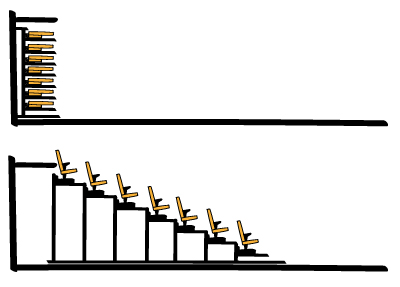
The initial function of retractable seating systems is to change the capacity of a space.
However, if there is a desire to reduce the sound reverberation, extra seating could be deployed (which is great also to increase the audience!).
Good seating systems are those that have similar absorption characteristics whether the seats are full and empty. This is because the human body absorbs sound too and you don’t want the sound reverberation to depend on the number of people attending an event.
Seating systems don’t necessarily have to be retractable, they can also be loose lightly upholstered seats or also seats rising from the floor using a very specialist mechanism (but this is expensive!).
Acoustic references
See below the references used to confirm the above concepts:
Auditorium Acoustics and Architectural Design – Mike Barron;
Acoustic Absorbers and Diffusers: Theory, Design and Application (Third Edition) – Trevor Cox and Peter d’Antonio
Sound Materials: A Compendium of Sound Absorbing Materials for Architecture and Design – Tyler Adams
